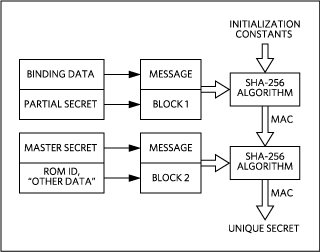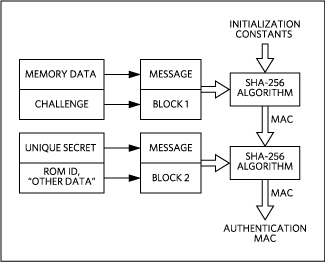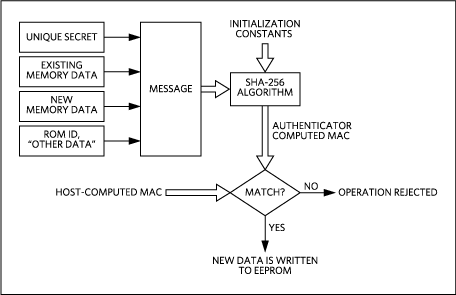Introduction to SHA-256 Master/Slave Authentication
要約
A new group of secure authenticators and a companion secure coprocessor/1-Wire® master implement SHA-256 authentication. This application note explains the general logistics of this SHA-256-based security system and introduces the bidirectional authentication functionality that the authentication system uses.
A similar version of this article appeared in EE Times, June 19, 2013.
Introduction
For more than 10 years, SHA-1 authentication has been used to effectively protect intellectual property from counterfeiting and illegal copying. As computer technology advances, customers are asking for an even higher level of security.
Today a new group of secure authenticators and a companion secure coprocessor implement SHA-256 authentication. This new system provides advanced physical security to deliver unsurpassed low-cost IP protection, clone prevention, and peripheral authentication. This article explains the general logistics of the SHA-256-based security system and introduces the bidirectional authentication functionality which the authentication system utilizes.
A Secure Authentication System
Implementing a secure authentication system requires linking a host system with a sensor/peripheral module. The system presented in Figure 1 consists of a 1-Wire® SHA-256 secure authenticator plus a SHA-256 coprocessor with 1-Wire master function. Operating between the host and peripheral over a single pin of the 1-Wire interface reduces interconnect complexity, simplifies designs, and reduces cost.1

Figure 1. Secure authentication system implementation. This system features the DS2465 SHA-256 coprocessor and the DS28E25 SHA-256 authenticator.
SHA-256 Authenticators
The SHA-256 secure authenticators in this system support a challenge size of 256 bits and use a 256-bit secret. The secure authenticator in Figure 1 is a 1-Wire slave with a unique 64-bit ROM ID that serves as a fundamental data element for authentication computations. The system designer can partition the authenticator's user EEPROM into areas with open (unprotected) access and into areas where the master must authenticate itself for write access. Table 1 shows the available protection modes and valid protection combinations.
| Protection Code | Description |
| RP | Read Protection. If activated, the data is only accessible for device internal use, e.g., like a secret. |
| WP | Write Protection. If activated, the data cannot be changed. |
| EM | EPROM Emulation Mode. If activated, individual bits can only be changed from 1 to 0. |
| AP | Authentication Protection. If activated, write access to the memory requires master authentication. |
| *The system default is no protection with RP, WP, EM, and AP not activated. Protection is cumulative. | |
SHA-256 Coprocessor with 1-Wire Master
The SHA-256 coprocessor in Figure 1 is an I²C slave controlled by a host processor. From the host's I²C port the SHA-256 coprocessor appears as a 256-byte read/write memory with certain regions (data elements) assigned for special purposes.
Security Logistics
SHA-based security relies on message authentication codes (MACs) computed from open data and a secret. To verify authenticity, both sides, i.e., the host or coprocessor and the 1-Wire authenticator, must know the secret, which shall never be exposed. Moreover, for maximum security the secret in each 1-Wire authenticator must be unique. In this way the security of the entire system is not affected if the secret of a single authenticator is ever compromised.
At first glance, it may appear impossible to meet these requirements. There is, however, a simple solution: compute the secret from known "ingredients" and install it into the device in a trusted/controlled manufacturing environment. The ingredients for an authenticator secret are a master secret, the binding data, a partial secret, the authenticator's ROM ID, and padding/formatting ("other data"). Figure 2 illustrates the process. Although the ingredients are exposed at one point in time, for example, in a trusted manufacturing environment, the computed secret is never exposed and always remains hidden.

Figure 2. Creating a unique authenticator secret.
For security and storage space reasons, the unique secrets of all authenticators in a system cannot be stored in the coprocessor or host. Instead, the coprocessor stores only the master secret and the binding data in a protected memory section. The partial secret is a system constant that can be coded in the host processor's firmware and communicated openly. After having read an authenticator's ROM ID, the coprocessor can compute the authenticator's unique secret, as shown in Figure 2. With both authenticator and coprocessor now sharing the unique authenticator secret, the system is ready to operate.
Challenge-and-Response Authentication
The primary purpose of an authenticator is to furnish proof that the object to which it is attached is genuine. Symmetric key-based authentication uses a secret key and the to-be-authenticated data ("message") as input to compute a MAC. The host performs the same computation using the expected secret and the same message data; it then compares its version of the MAC to the one received from the authenticator. If both MAC results are identical, the authenticator is part of the system.
In this SHA-256 authentication system, the message is a combination of host challenge and data elements stored in the authenticator. It is crucial that the challenge is based on random data. A never-changing challenge opens the door to replay attacks using a valid, static MAC that is recorded and replayed instead of a MAC that is instantly computed.
The authenticator computes a MAC from the challenge, the secret, memory data, and additional data that together constitute the message (Figure 3). If the authenticator can generate a valid MAC for any challenge, it is safe to assume that it knows the secret and, therefore, can be considered authentic.

Figure 3. Computing a challenge-and-response authentication MAC.
Data Security (Authenticated Write)
Beyond proving authenticity, it is highly desirable to know that the data stored in the authenticator can be trusted. For this purpose, some or all of the EEPROM in a secure authenticator can be "authentication protected." With authentication protection activated, memory write access requires that the host presents proof of its authenticity by providing a host authentication MAC to the authenticator (Figure 4).

Figure 4. Authenticated write access (host authentication MAC).
The host authentication MAC is computed from the new memory data, the existing memory data, the authenticator's unique secret plus ROM ID, and other data that together constitute the message. The authenticator computes a MAC in the same way, using its secret.
An authentic host has recreated the authenticator's secret and can generate a valid write-access MAC. When receiving the MAC from the host, the authenticator compares it to its own result. Data is written to the EEPROM only if both MACs match. User memory areas that are write protected cannot be modified, even if the MAC is correct.
Secret Protection
The authenticator's secret and the coprocessor's master secret are read protected by hardware design. If desired, the secrets can be write protected, which prevents tampering with the authenticator's memory data by replacing unknown secrets with known secrets. After installation, the binding data, which is typically stored in the coprocessor's memory, should be read protected. This level of protection is effective as long as the coprocessor and authenticator are set up for the application at a trusted production site.
DeepCover
The deployment of DeepCover® technologies provides the strongest affordable protection against any die-level attacks that attempt to discover the secret key. DeepCover technologies include numerous circuits to actively monitor for die-level tamper events, advanced die routing and layout techniques, and additional proprietary methods to counter the sophisticated capabilities of attackers.
Bidirectional Authentication
The secure authenticators in the example system here support both challenge-and-response authentication and authenticated writes (host authentication). The entire user memory can be used for challenge-and-response authentication. Bidirectional authentication applies to memory areas configured for secure data storage (authenticated write).
Summary
With 256 bits each for the secret, challenge, and MAC, SHA-256 is a significant improvement over older SHA-1 authentication. This article presented a modern, secure authentication system that matches a host system (a SHA-256 coprocessor with 1-Wire master) with a sensor/peripheral module (the 1-Wire SHA-256 authenticators). The coprocessor's built-in 1-Wire master relieves the host from performing 1-Wire communication in real time. DeepCover 1-Wire SHA-256 authenticators are available in three memory configurations for 3.3V and 1.8V operation.2, 3 Also available for 3.3V and 1.8V, the coprocessor/master4, 5 works with all three authenticators. SHA-256 security has never been easier.
参考資料
1 A general introduction to mutual authentication is found in Maxim Integrated application note 3675, "Protecting the R&D Investment with Secure Authentication."
2 Analog data sheets DS28E15, DS28E22, DS28E25 for 3.3V operation.
3 Analog data sheets DS28EL15, DS28EL22, DS28EL25 for 1.8V operation.
4 Analog data sheet DS2465 for use with DS28E15, DS28E22, DS28E25.
5 Analog data sheet DS24L65 for use with DS28EL15, DS28EL22, DS28EL25.